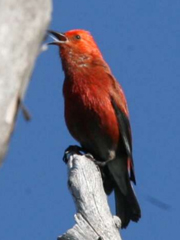|
'APAPANE } Himatione sanguinea

|
RANGE: Hawaii, Maui, Lāna'i, Kaua'i, Moloka'i and O'ahu
STATUS: Though this bird isn’t considered endangered, it is relatively low in numbers and faces many of the same threats as other Hawaiian honeycreepers.
THREATS: Avian disease, predators, habitat degradation, global warming
The bright crimson feathers of the 'apapane, a type of honeycreeper, once adorned the capes, helmets and leis of native Hawaiian nobility. One of Hawaii’s most active singers at all times of the day, the male of the species has six different calls and about 10 distinct recorded sound patterns, from chirping to whistling to singing — and during breeding season, the aggressive males that sing the loudest always win the females’ attention. Seeking nectar from the flowers of 'ōhi'a lehua trees, 'apapanes roam in small flocks through the high-elevation forest canopies of six of the eight windward Hawaiian islands. Among the greatest threats to this bird are introduced predators, such as small Asian mongooses, and deadly avian malaria. The ‘apapane has an extremely high prevalence of avian malaria because of its seasonal migrations to lower-elevation forest, where malaria-carrying mosquitoes thrive. Though no active conservation efforts are underway for this species in particular, steps to protect other local birds — like the removal of predators and habitat-destroying livestock animals — are helping this bird as well.
|